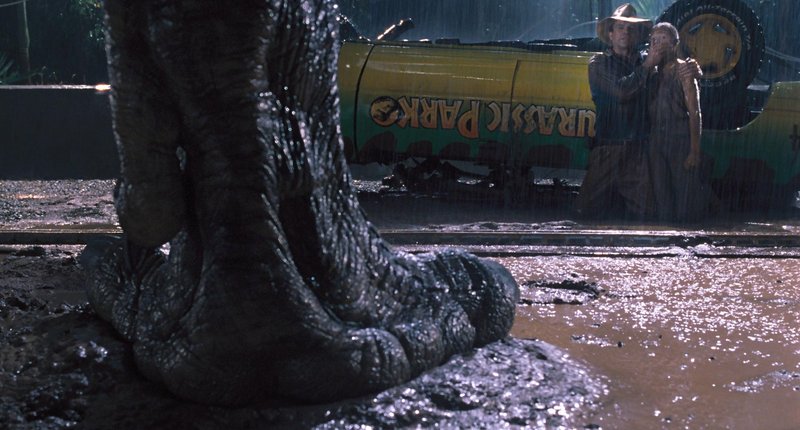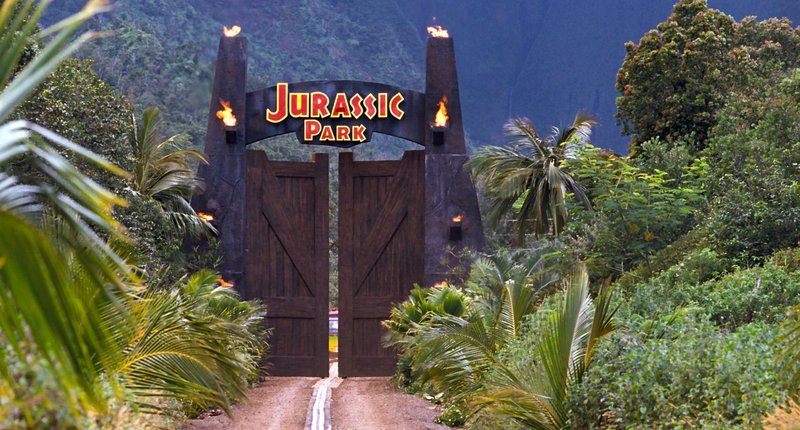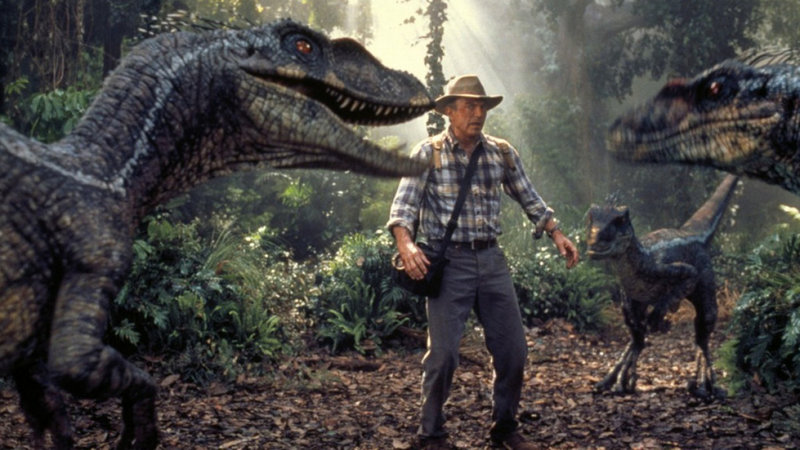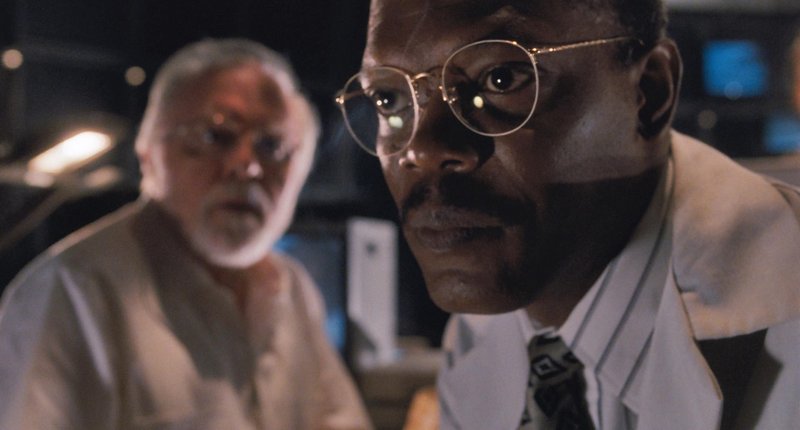Imagine yourself in the Cretaceous Period,” says paleontologist Alan Grant in the opening minutes of Steven Spielberg’s “Jurassic Park.” Played by a sun-tanned Sam Neill, Grant is explaining to a mouthy kid what it would feel like to be hunted down by velociraptors, the wily dinosaurs who have since terrorized millions of moviegoers worldwide.
The point is, you are alive when they start to eat you,” says Grant. “So, y’know — try to show a little respect.
Twenty years after its release in the summer of 1993, “Jurassic Park” returns to theaters Friday in 3-D and IMAX. It’s surely the opening salvo in Universal’s publicity campaign for next year’s planned sequel, “Jurassic Park 4,” but it’s also a chance to see whether Spielberg’s big, brainy, science-savvy blockbuster will command respect from modern audiences. Will the movie’s pioneering computer-generated effects still dazzle in 2013? Will its notions of cutting-edge technology pass the smell test? And beyond its massive popularity — $914 million in ticket sales, a box-office record not broken until James Cameron’s 1997 epic “Titanic” — what is the larger legacy of “Jurassic Park”?
“It’s a real watershed for popular culture,” says Matthew Carrano, curator of dinosauria at the Smithsonian’s National Museum of Natural History in Washington, D.C. “Dinosaurs were always popular with children, but post-‘Jurassic Park,’ dinosaurs are much more acceptable across the board. Now there are adults who find dinosaurs interesting, and aren’t embarrassed about it.”
“Jurassic Park” captured imaginations of all ages with a simple premise: A wealthy entrepreneur, John Hammond (Richard Attenborough), is bringing dinosaurs to life after 65 million years of extinction. Using tattered dino DNA taken from ancient mosquitoes preserved in amber, and plugging the gaps with fresh frog DNA, scientists can clone everything from a galloping Gallimimus to the towering Tyrannosaurus. Hammond’s dream is a dinosaur theme park, though several humans — including Laura Dern and a pre-fame Samuel L. Jackson — find themselves living in a splattery nightmare.
It’s based on the book by Michael Crichton, the late Harvard-educated doctor turned author and filmmaker, whose stories often mixed science-fiction with real facts. “The Andromeda Strain,” his bestselling book of 1969, imagined an extraterrestrial microorganism that clots human blood; his 1981 thriller “Looker,” which he wrote and directed, wondered what would happen if 3-D digital modeling were applied to humans.
“Jurassic Park” was even more believable. By 1993, scientists already had been extracting DNA fragments from amber-encased creatures, including a 30-million-year-old termite. “Jurassic Park” met with some mockery — “Frogs are amphibians, dinosaurs are reptiles,” fumed paleontologist Stephen Jay Gould, dissecting the movie in The New York Review of Books — but lay audiences were convinced. Even Gould admitted, “The dinosaur scenes are spectacular.”
“Plausibility was paramount,” says David Koepp, who co-wrote the screenplay with Crichton. “The DNA idea about mosquitoes and blood, you get it. You take one look at it and you just understand. That removed the movie from the Godzilla type of movie, where you say, ‘Well, there’s some kind of radiation, and he starts stomping bridges.’ This took things into the realm of science-fact.”
Underscoring the film’s authenticity was John “Jack” Horner, the paleontologist widely credited as the inspiration for the character of Dr. Grant. The fictional Grant, who insists that dinosaurs were close cousins to birds, certainly sounds like Horner, who in the mid-1970s helped excavate a new dinosaur genus, the nesting Maiasaura. Horner served as a consultant on the film (and all its sequels, including No. 4) and claims credit for Grant’s trademark accessories, the straw hat and red neckerchief.
“My job was to make sure the dinosaurs looked as accurate as they could for the science we had at the time,” says Horner, curator of paleontology at the Museum of the Rockies in Bozeman, Mont. “Steven had them behave the way he wanted them to behave, but my job was to make sure they looked good and to make sure the actors pronounced their scientific names right.”
The outlandish character of chaos theoretician Dr. Ian Malcolm, memorably played by Jeff Goldblum, has been compared to several real-life mathematicians — from Mitchell Feigenbaum to James Gleick, author of the 1987 bestseller “Chaos: Making a New Science” — but Malcolm’s aggressive sexual energy and rock-star arrogance were exaggerated for the movie, according to Koepp.
“It was a challenge, from the writing and acting standpoint, to present anybody who was remotely interesting next to the dinosaurs,” says Koepp. “If anyone comes out and starts talking about their personal life, you’d just wish they’d be quiet so you could look at the dinosaurs. But he could hold his own opposite the prehistorical wonders.”
“Jurassic Park” has gone down as one of the most aggressively merchandised films in history, but Carrano, the 43-year-old curator at the Smithsonian’s natural history museum, sees a different legacy.
“I probably have a job because of that,” he says. For decades, museums regarded dinosaur paleontology as a marginal field, and few bothered to hire experts on staff, according to Carrano. After “Jurassic Park,” however, “museums responded. The major museums, just about everywhere you can think of in a sizable place, have all brought somebody in over the last 20 years.”
He adds: “It’s always challenging to connect people with science. And I think ‘Jurassic Park’ has done us a big service.”
Following the record-breaking success of “Jurassic Park” in 1993, Universal Pictures issued two sequels at the rate of one every four years: “The Lost World: Jurassic Park” in 1997 and “Jurassic Park III” in 2001.
Since then, nothing.
Now news is trickling out about “Jurassic Park 4.” Questions abound: Which actors will return? Who will direct?
Here’s who won’t be returning: writer Michael Crichton and the special effects wizard Stan Winston, both of whom died in 2008. Screenwriter David Koepp, who worked on the first two films, says he declined.
“One movie takes a lot of thinking on a subject, two movies takes an enormous amount, and I just didn’t feel like I had enough fresh thinking,” Koepp says. “I’ll be first in line to see it, though.”
So who is returning? One is Sam Neill, though he confirmed his involvement several years ago. Another is paleontologist John “Jack” Horner, a consultant on the previous films. Rick Jaffa and Amanda Silver, of “Rise of the Planet of the Apes,” are reportedly the screenwriters. The director is Colin Trevorrow.
The big question, though, concerns feathers. Since ’93, scientists decided that many dinosaurs probably had feathers, a notion that could impact the look of the new film. Horner claims the film will include a higher feather count. Trevorrow recently tweeted: “No feathers.”
“Jurassic Park 4” is due in theaters June 13, 2014.
Send questions/comments to the editors.






Success. Please wait for the page to reload. If the page does not reload within 5 seconds, please refresh the page.
Enter your email and password to access comments.
Hi, to comment on stories you must . This profile is in addition to your subscription and website login.
Already have a commenting profile? .
Invalid username/password.
Please check your email to confirm and complete your registration.
Only subscribers are eligible to post comments. Please subscribe or login first for digital access. Here’s why.
Use the form below to reset your password. When you've submitted your account email, we will send an email with a reset code.